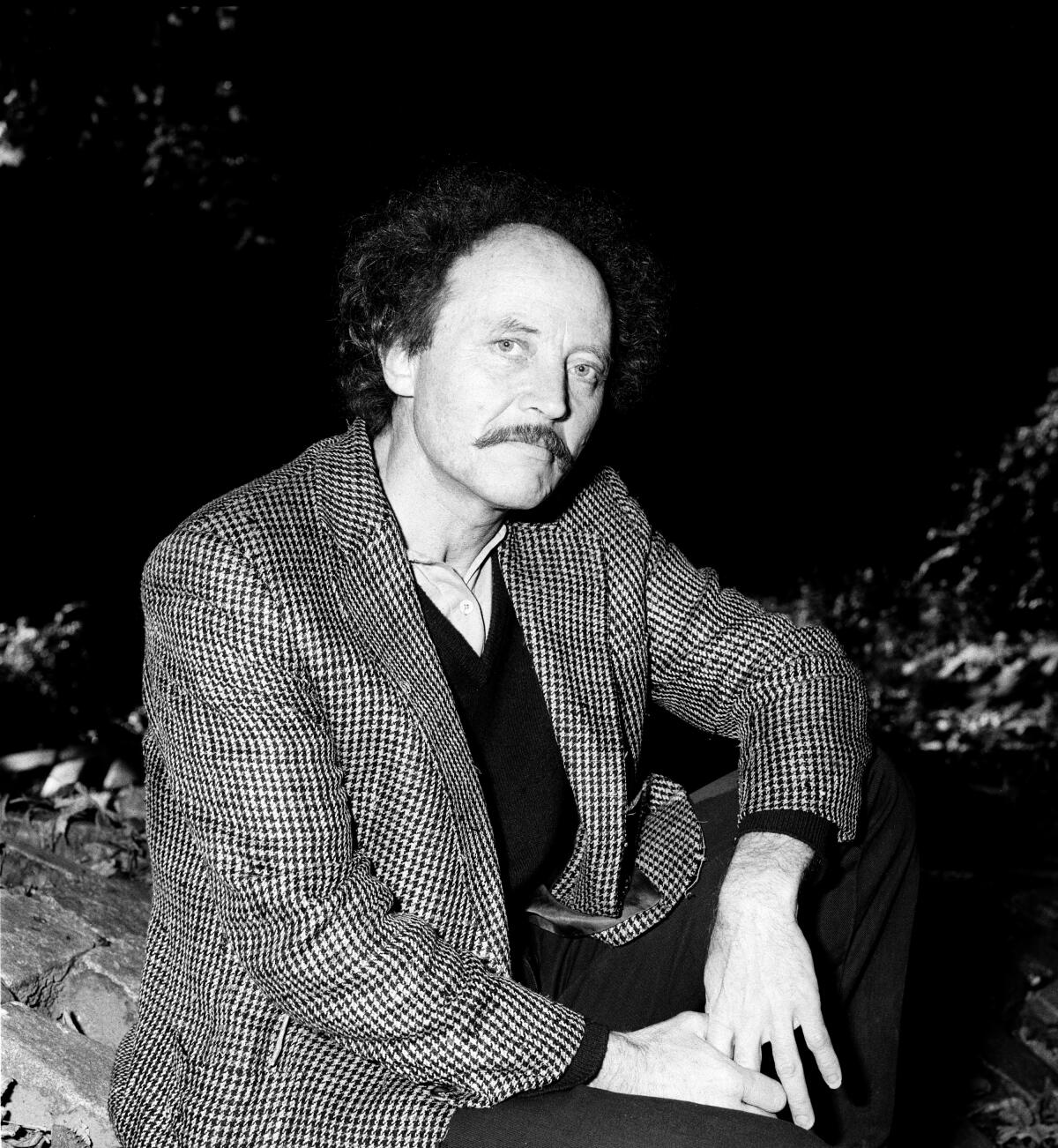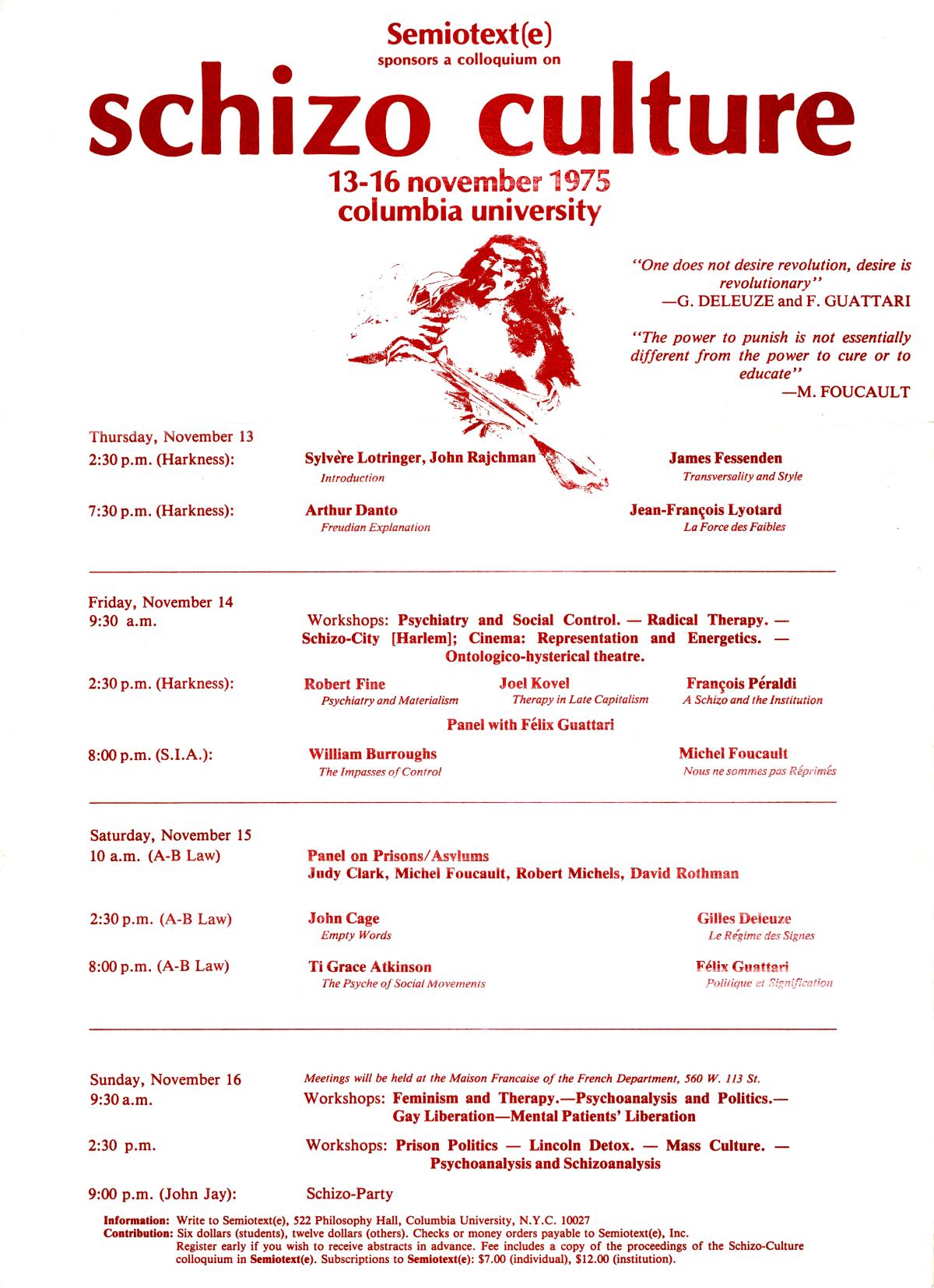Sylvere Lotringer, intellectual who infused U.S. art circles with French theory, dies at 83

In November of 1975, a French literary scholar at Columbia University by the name of Sylvère Lotringer, along with a student, John Rajchman, organized a four-day colloquium that was intended to bring together a wave of avant-garde French theorists with various representatives of downtown New York City demimondes â presumably to discuss themes related to âprisons and madness.â
But âSchizo-Culture,â as the conference was titled, didnât go quite as planned.
Early on, the narrow literary theme was scrapped in favor of what writer and researcher David Morris later described as âa delirious post-sixties intellectual free-for-all.â French philosopher Michel Foucault prepared a paper about repression; Gilles Deleuze was slated for a session about the interpretation of signs. Also on board was experimental composer John Cage, who was to deliver a chance-generated piece titled âEmpty Words.â
It remained delightfully eggheaded until the Village Voice featured the colloquium as its âpick of the weekâ and more than 2,000 people descended on Columbia for the event. Fights broke out. Panelists attacked each other. During Foucaultâs presentation, an attendee stood up and accused him of being a paid agent of the CIA. (He was not.) FĂŠlix Guattari, another French philosopher, impetuously canceled his own panel moments before it was set to start. âI am the chair of this panel and I abolish this panel,â he reportedly stated and then got up and left â as did a good portion of the audience.
At the center of it all was the affable Lotringer. In the 2014 book, âSchizo Culture: The Book, The Event,â he recalled the chaos of the proceedings: âFoucault vented his furor and frustration at the conference. It was a scandal, he said; he had never seen a worse audience before; New Yorkers were horrible, the conference a sham.â

âSchizo Cultureâ may have seemed, in its moment, like little more than abject confusion. But it left a mark on intellectual culture in the United States. The event has been chronicled and re-chronicled, its happenings resuscitated at anniversary events. It also helped connect a generation of French philosophers â theorists who came of intellectual age in the wake of the events of May â68, a season of protest that marked a cultural shift in France â with an artistic avant-garde of New York City. In addition to Cage, cut-up writer William Burroughs, experimental playwright Richard Foreman and underground filmmaker Jack Smith all attended the colloquium.
Lotringer served as critical connective tissue in myriad other ways, too. He founded the intellectual journal Semiotext(e), which later evolved into an ongoing publishing imprint of the same name. A lively intellectual hub, the company â which relocated to Los Angeles in the early 2000s â has published work by figures such as poet Eileen Myles, critic Gary Indiana and writer Chris Kraus.
Kraus has served as co-editor of the imprint since the 1990s and for a time was married to Lotringer. To the pop culture enthusiast, Lotringerâs name may therefore be more recognizable as Krausâ husband from her groundbreaking 1997 work of autofiction, âI Love Dick,â which explores her desires for another man, followed by desire more abstractly â all with Lotringerâs blessing.
When the book was made into a TV series by Joey Soloway in 2017, the part of Lotringer was played by Griffin Dunne.
Lotringer, a probing yet approachable scholar whose curiosity was sparked by a wide range of subjects â from French theory to graffiti â died of an undisclosed illness at his home in Ensenada, Mexico, on Monday. He was 83. He is survived by his wife, Iris Klein, and his daughter Mia Marano, along with Maranoâs two children, Jonah and Nico Marano.
âI Love Dickâ crams a lot of life into a double entendre.
Kraus remembers a brilliant scholar who was also an empathetic teacher. âHe could meet people on their level and communicate this wealth of ideas to them,â she says via telephone. âSo many people talk about how meeting Sylvère and hearing him made them change their lives. For him, all of this learning and all of this philosophy was a tool for living a more purposeful and meaningful life.â
Actor and writer Jim Fletcher, a founding member of the New York City Players theater company who first met Lotringer in the â80s, and who wrote poignantly about âSchizo-Cultureâ for a 2014 issue of Artforum, describes an âelectricalâ personality. âConversing with him was always a thrill,â he says. âIt wasnât because of these massive articulations but because all of a sudden, whatever we were talking about became alive right in front of you â like touching a live wire.â

Sylvère Lotringer was born on Oct.15, 1938, in Paris, to Denise and Claude Lotringer, Jewish immigrants from Poland. His mother was trained as a pharmacist, but in France the family made a living as furriers, employing their humble apartment as an atelier. âThey would cut furs on the living room table by day and use it as a bed for the children at night,â recalled Lotringer in a 2016 essay about his youth. âI can still feel the hair flying in my nose.â
It was a tenuous existence. The family kept rabbits in the buildingâs courtyard, one of which the young Lotringer took on as a favorite pet. But deprivation forced his parents to serve the animal for food. âSylvère,â says Kraus, ârefused to eat it.â
The Nazi occupation of France brought additional cruelties. Lotringer and his older sister, Yvonne, however, were among the lucky ones. They evaded the camps thanks to the kindness of their schoolâs headmistress, who through her connections with the RĂŠsistance secured fake identity papers. The pair were sent to live in the countryside as so-called âhidden children.â
âHe was told, as a child, âYou must never say your name or everyone in the house will be killed,ââ says Kraus. For the duration of the war, Lotringer was âSerge Bonnardâ and his sister Yvonne was âHughette.â His parents survived in hiding as well.
Lotringer was not yet 7 years old when, in 1945, World War II came to an end and he was reunited with his parents. According to family lore, when the French flag was raised in their townâs square, Lotringer turned to his mother and said, âItâs so beautiful I want to die.â
Jacques Derrida, the influential French thinker and writer who inspired admiration, vilification and utter bewilderment as the founder of the intellectual movement known as deconstruction, has died.
Marano says these early experiences shaped her fatherâs world view: âAs someone who had been considered, as a child, an outsider, he was also really sympathetic throughout his life to people who had been marginalized.â
For a time, after the war, the family relocated to Israel. But with little economic opportunity there, they returned to France, where they ran a grocery store. It was one of his Paris schoolteachers who noticed Lotringerâs potential and helped him get into a prestigious secondary school, where he excelled.
This was followed by studies at the Sorbonne, where he co-founded the literary magazine LâEtrave. He went on to the Ăcole Pratique des Hautes Ătudes, where he wrote his doctoral dissertation on Virginia Woolf â with supervision from Roland Barthes and Lucien Goldmann.
It was an early example of his commitment as a scholar: Lotringer took the extra step of traveling to London to interview the surviving members of the Bloomsbury Group. It was also an example of his politics. He had enrolled at the Ăcole Pratique to avoid serving in Franceâs war with Algeria.
âMy education was a casualty of the war,â he told the Brooklyn Rail in 2006. âI got my PhD as a way of postponing the draft. Algeria was our Vietnam, and I wasnât exactly keen on being sent there.â
After a succession of teaching jobs in Turkey, Australia and the U.S., he landed in New York in 1972, âhoping to catch up with the student rebellion at Columbia.â He would remain there â in the universityâs French and comparative literature department â for more than three decades.
Two years later, he and his then-partner Susie Flato and grad student John Reichman established Semiotext(e), an intellectual journal that explored philosophy and politics as well as topics like polysexuality. A single issue might feature a text by Deleuze along with interviews of a female street gang from the Bronx. Text was not necessarily connected to images, many of which, as Fletcher once noted in an essay in Artforum, âhad a pronounced s/m bent.â
The magazine remained in print until 1983, when Lotringer turned to publishing French theoreticians in translation under the Semiotext(e) name. Known as the âForeign Agentsâ series, the little black books fit easily in a pocket. âFootnotes or other academic commentary were conspicuously absent,â Lotringer later wrote of the series. âTheir place was in a the pockets of spiked leather jackets as much as on shelves.â
Kate Zambrenoâs process is rumination and frenzy. Thatâs how she completed âTo Write as if Already Dead,â an homage to the late writer HervĂŠ Guibert.
He met Kraus in 1980 â a pairing that for many years was romantic but ultimately settled into being a lifelong intellectual collaboration.
Kraus was staging a play titled âDisparate Action/Desperate Action,â and she invited 10 people she considered famous to the show. A fan of Semiotext(e), she included Lotringer on the list. âHe was the only one who came,â recalls Kraus. âSusan Sontag didnât.â
Their first affair was brief, but they bumped into each other three years later at a poetry reading and reignited their relationship; they married in 1988. Kraus joined Semiotext(e) in the 1990s. Noting that its publications were heavily male, she launched âNative Agentsâ series, which focused on literature by women.
Lotringer and Kraus separated in 2004 and divorced 10 years later. Kraus addressed their relationship in direct and indirect ways in a pair of novels, including âI Love Dick.â
Lotringer, she says, was âan unbelievably good sportâ about appearing in her work and, later, in a TV series. âSylvère always had a sense of humor and never took himself too seriously.â
By the early 2000s, Semiotext(e) had relocated to Los Angeles with artist Hedi El Kholti as co-editor. This collaboration has further expanded the areas explored by Semiotext(e) to include other subjects, such as queer theory.
Gayatri Chakravorty Spivak, a humanities professor at Columbia who first met Lotringer in the â70s, said he embodied the spirit of that era.
âI thought of him as a primary text, not a commentator on radical theory, but as part of a way of thinking and doing which very much belonged to the â70s in France and radical New York and then California,â she said.
His influence, she said, was less rooted in his writing than in his way of life.
âHe was not the kind of person who would necessarily leave an influence on scholarly thinking,â she added. Rather, he was âan example of how this kind of philosophy is also an act of the mind, of life, of how to actually live philosophically rather than simply think in a certain way.â
In âThe Last Man Takes LSD,â two authors track Foucaultâs late-in-life rightward turn, beginning with a hallucinogenic 1975 visit to Death Valley.
Lotringer was published extensively throughout his life, collaborating with French theorists Paul Virilio (âPure War,â âCrepuscular Dawn,â âThe Accident of Artâ) and Jean Baudrillard (âForget Foucault,â âOublier Artaud,â âThe Conspiracy of Artâ). In 2007 he wrote âOverexposed: Perverting Perversions,â an update of Foucaultâs âHistory of Sexualityâ from 1976, and in 2001 he teamed up with Kraus for âHatred of Capitalism: A Semiotext(e) Reader,â which features writing by many of the thinkers who influenced him.
El Kholti says Semiotext(e)âs long-running success â unusual for an imprint that is not supported by a university or a publishing conglomerate â speaks to Lotringerâs passion for living, but also the curiosity and the empathy he brought to learning.
âI think of doing something with integrity for that long, it has this influence in the culture,â he says. âItâs rare.â
More to Read
Start your day right
Sign up for Essential California for the L.A. Times biggest news, features and recommendations in your inbox six days a week.
You may occasionally receive promotional content from the Los Angeles Times.









